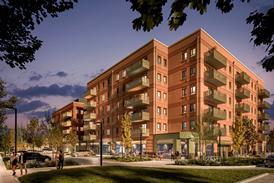The French and British capitals are very different, but still have much to teach each other, writes Daniel Pöhner

The ban that Paris has reinstated on new tall buildings poses the question of whether similar restrictions should be made in other cities in Europe and the UK. Over recent years we’ve seen the rapid reshaping of London, as powerful developers buy up large parts of the city and bring huge change to existing communities and the skyline.
The concern in Paris was not just that high rise buildings would disrupt the city’s homogeneous design. Parisians were also worried about the potential impact on the economic and social life of the city. Could Paris’s unique character and identity withstand the urban and economic pressure that new high rise developments sometimes bring with them?
It’s important to highlight the fact that Paris is unlike the more decentralised London. It resides within an inner ring road, the Boulevard Périphérique, cutting the relatively compact and wealthy centre off from its surrounding suburbs.
The controversial building that has prompted the reinstated height restriction, Herzog & de Meuron’s Tour Triangle tower, was being constructed adjacent to the Périphérique, with the intention of creating a new centre of economic and social gravity outside the historic city core.
The city had been attempting to build better connections to these historically neglected suburbs, allowing high rise buildings in specific zones around the Périphérique, as part of the Grand Paris programme. This plan includes a new orbital railway encircling the city – the largest infrastructure programme in Paris in the past 30 years.
Planning policy differs immensely between London and Paris, with the French capital having a document which specifically outlines what can and cannot be built. Anyone building in Paris must comply with Le Plan local d’urbanisme (PLU). France has a non-discretionary system – developers cannot haggle with the planners over adding another two or three floors to maximise their profit margins.
One may argue that London is too lax, with approval being dictated by politics and negotiation weighing too heavily over policy. But perhaps this freedom also results in a more lively mix of differently scaled buildings across the landscape; the contrast of modernity and tradition enriching London and helping generate an ever-young positive energy.
Consider what would happen if strict height restrictions were imposed in the next London Plan, potentially sending an unwelcome signal to the international property asset investors who fund these developments.
Tall residential and commercial space is often more cost effective to build, especially when land is a scarce and expensive resource. If the height of new builds was limited in London, that could push developers towards replacing more existing stock in conservation areas, as well as in traditional mid and low-rise parts of the city.
What we can most certainly learn is that the focus should be people driven, not business driven. Perhaps it is fair to say Paris is more concerned with the needs of its citizens than London. The British capital seems more dependent on the finance sector and interested in staying attractive to large corporate investors.
But my view is that the impact of high rise developments around the centre of Paris are not yet clear. It’s too early to say whether they have had a negative impact on the city and its suburbs.
To impose a long-term and restrictive ban in Paris seems unrealistic. It would be more sensible to monitor the project pipeline on a case-by-case basis and tap into those areas of potential and improvement for city.
The French capital should perhaps be willing to take a more pragmatic approach – resisting the free-for-all we have seen in London, while still allowing good high rise development to occur where it benefits the suburbs and wider city.
Postscript
Daniel Pöhner is a director at Baumschlager Eberle Architects
















4 Readers' comments